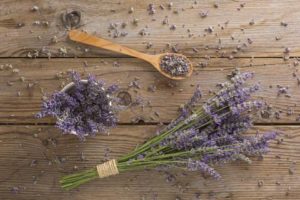I once lived a on a magical little farm and had a fairy godmother landlord. It was a great place to be an herbalist. But…the house I lived in also housed a small country’s worth of moths. Some of them hitchhiked with me to my new place, as evidenced by the the occasional moth fluttering around the bedroom and holes I sometimes find in my shirts.
No need for toxic and stinky mothballs! Instead, here are 5 great-smelling botanicals to choose from for sending your unwanted visitors-of-the-moth-kind away.
Patchouli (Pogostemon species) Patchouli came to Europe after Napoleon brought some cashmere shawls back to Paris. The shawls were decorated with what later would be referred to as “paisley”, but more relevant, they were scented with patchouli to protect the them from moths. The scent became wildly popular, as did the shawls. Patchouli leaves can be stashed in clothing drawers to keep moths away, or you can use the distilled oil.
Lavender (Lavandula stoechas, Lavandula latifolia)
Lavender has traditionally been used to ward off moths. Certain species of lavender have appreciable amounts of the essential oil compounds 1,8-cineole and camphor that have activity against moths. Either lavender essential oil or dried lavender in a sachets can be used. Either will also make your clothing smell lovely.
Bay Laurel (Laurus nobilis)
If you live in a mild enough climate, you can grow your own bay and use the leaves in a sachet (and cook with them, too). Where I live at 6500 feet, forget about growing bay outside of a greenhouse. So, I use the essential oil. Bay is also a mood uplifting oil, so you can feel good while keeping the moths…..at bay (sorry!!!).
Cedarwood (Cedrus species)
One of my earliest memories is the scent of the cedarwood closet. It was in a cabin I spent time in as a young child; my folks sold the cabin by the time I was 6 but the memory is still strong. (Scent is one of the strongest évocateurs of memory.) More related to moths, cedarwood is an effective moth repellent, whether you’re using a chunk of the aromatic wood or the distilled oil. This is one of the reasons cedarwood chests are popular (as well as cedarwood closets). If neither is going to show up in your life any time soon, use the oil!
Rosemary (Rosmarinus officinalis)
The scent of rosemary out competed several other essential oils as a moth repellent. It’s another uplifting scent that’s also great for memory. If these qualities are appealing to you, why not have rosemary scented clothes! It’ll also keep your clothes from being holey. If you’re lucky enough to have rosemary in your garden, toss some sprigs in your dresser drawers and hang some bundles in the closet.
A few ways to use essential oils:
- Make a natural drawer liner out of canvas scented with several drops of oil
- Add a couple drops of oil to a few cotton balls or pieces of cloth to stick in the drawer
- Cut a hole in a piece of cloth and poke the top of a clothes hanger through for scenting your closet
References/Further Reading
Keville, K (1999) Aromatherapy for Dummies. Wiley Publishing. Indianapolis.
Worwood, VA (1991) The Complete Book of Essential Oils & Aromatherapy. New World Library. San Rafael.
~~~
Content © Dr. Anna Marija Helt, Osadha Natural Health, LLC. Permission to republish any of the articles or videos in full or in part online or in print must be granted by the author in writing.
The articles and videos on this website for educational purposes only & have not been evaluated by the Food and Drug Administration. This information is not intended to diagnose, treat, cure, or prevent any disease or to substitute for advice from a licensed healthcare provider.

